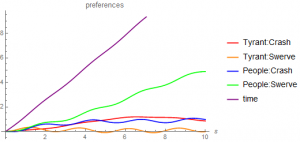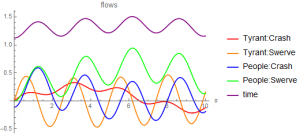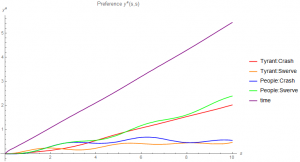This site is part of a project on understanding decision making that starts with the Theory of Games and extends to the Field Theory of Games that uses deterministic techniques from differential geometry and physics. The latter techniques have proved useful in electrical engineering, meteorology and general relativity. The approach has much in common with the techniques of systems dynamics. Using tools of Computational Engineering from the Wolfram Language, this approach provides insights into such diverse topics as the prisoner’s dilemma in game theory, ethical issues of the tragedy of the commons and current day strategic economic behaviors. The applications of such a theory extend to most common day experiences of decision-making. Anyone that is familiar with decision-making knows that it requires leadership, accountability, integrity and innovation. An outcome of the analysis suggests that these concepts fit naturally into the dynamic theory.
The overarching goal of the website is to provide information to people who want to understand the dynamics of decision making, and further, to provide the tools to compute the dynamics. What this site can realistically do is a small piece of that: it can provide new attempts at understanding decision making, and the tools that have been created using the field theory of games and the Wolfram Language. It does not claim to provide an exhaustive overview of what everyone else in the world has done.
Here is a short history of what has been done. For an early introduction, see the PowerPoint 2011 Wolfram Technology Conference Talk, a CDF talk Wolfram Technology Conference 2012 Talk, or the YouTube Video of that talk, which was given at the 2012 Wolfram Technology Conference held October 17-19, 2012. The presentation can be viewed using the free Wolfram CDF Reader. For a published introduction of decision process theory, see Geometry, Language and Strategy, Thomas, 2006, World Scientific (New York) and Geometry, Language and Strategy–Vol. 2 Dynamic Decision Processes, Thomas (World Scientific, 2016), which is a published version of this early draft, which can be found on the current website:
Subsequent to this work, additional progress has been made, especially in providing computational support to compute dynamic results. See A Field Theory of Games: An Introduction to Decision Process Engineering, Volume 1, Thomas, 2021, Wolfram Media, Inc., and A Field Theory of Games: An Introduction to Decision Process Engineering, Volume 2, Thomas, 2023, Wolfram Media, Inc.
What you may learn on this site: Decision process theory is a trans-disciplinary mix of ideas of geometry, language and strategy, starting with a causal foundation built from the language of differential geometry, using and implementing ideas such as gauge theory (Maxwell’s theory of electromagnetism, Einstein’s general theory of relativity, least action, geodesics, etc.), unification theories (such as Kaluza Klein, super symmetry, Higgs scalars, etc.), and the solution space associated with such theories such as harmonic wave phenomena (light waves, gravity waves, elastic vibrations); you will also find an application domain foundation based on the game theory of Von Neumann and Morgenstern including the normal form for competitive and cooperative games, Nash equilibrium, open problems in the literature such as the prisoner’s dilemma, attack defense models, inequality models, the invisible hand (Adam Smith), tragedy of the commons, dynamic games and a critique of Bayesian probability; as the third component of the mix, you will find practical applications in the spirit of systems dynamic thinking to contemporary issues and related ideas, such as the early work of the Club of Rome (Meadows) and more recent ideas such as network science (Barabási).
This mix is synthesized into a single package called decision process theory, which I hope will both educate and stimulate thought for a better understanding of decision processes. The presentations on this site are expected to range from philosophical discussions to presentations of exact solutions (to the field equations, which are analogous to those of general relativity) that illustrate this new way of looking at decisions. In the process of creating decision process theory, a number of distinctions were created with precise meanings and are defined and discussed in-depth on this site: causality, aggression and limits to greed, network connectivity, still point and free fall, harmonic standing waves, acceleration, code of conduct, entitlement, engagement, player interest, player passion, mutual player support, and strategies that are hidden-in-plain-sight.
SITE ORGANIZATION: The site is organized around five major areas. Three of them provide personal background on the author: About Me, Contact Me and Projects. The remaining two provide resources for understanding decision process theory: Inquiry and White Papers. Mathematica notebooks will be found with the White Papers.




